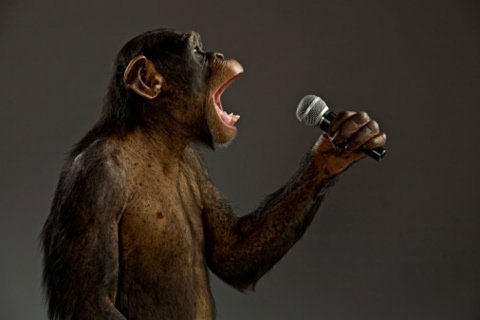New hypothesis about human language
Scientists believe that expressive movements in primates are different from chewing motions and become the basis for language development.
>>>Decoding language of elephants
There are different theories that explain the emergence of language in humans. One of these hypotheses suggests that the beginning is the sound signal of primates.
The monkey was born, but they could not communicate by sound and hundreds of millions of years had passed , their 'language' had not changed. And the language of a person is developed, increasingly rich from one life to another.

Human language ability comes from the expressive grimace of a monkey.
According to a new hypothesis proposed by Princeton University scientists (US), human language ability comes from the expressive grimace of a monkey.
Most monkeys are grumpy. They 'mingle' with each other when friendly contact without sound. Their vocal cords and larynxs did not move. The language only appears with the participation of two systems: the respiratory muscles make the air impact the vocal cords and the sound changes according to the movement of lips, cheeks and tongue. Expressive movements do not emit a sound on their own, but without it language will not develop.
The researchers tried to find out if there was any resemblance between the babble of the monkey and the babbling of the newborn.
When a child practices pronunciation, initially expressive movements are very slow and have different rhythms. As they grew older, language expression gradually became faster and more orderly. Unlike the expressive movement, chewing motion is formed from the day of new birth. This proves that these movements are controlled by different parts of the nervous system.
The scientists also observed all the activities of the long-tailed golden monkeys of different ages and noticed gestures and expressive postures that developed similar to human pronounced movements. The expressive movements in monkeys complete gradually without depending on the chewing motion. It should be mentioned that monkey and human chewing movements occur in the same period.
- Human language derives from the song of apes and birds
- Future technology helps people talk to animals
- What language did the ancients use?
- Humans know how to say it thanks to a genetic mutation
- Science thinks dogs can talk like humans
- People use fluent eyes language from birth
- The first orangutan in the world nearly learned how to speak human language
- Programming language history
- Affirm the migration hypothesis of ancient people
- New discovery about the evolution of language
- Unknown things about animal language
- Restoring ancient language
 'Fine laughs' - Scary and painful torture in ancient times
'Fine laughs' - Scary and painful torture in ancient times The sequence of numbers 142857 of the Egyptian pyramids is known as the strangest number in the world - Why?
The sequence of numbers 142857 of the Egyptian pyramids is known as the strangest number in the world - Why? History of the iron
History of the iron What is alum?
What is alum?